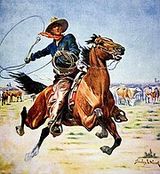American frontier
| American frontier is part of a series on Westerns |
|---|
|
Media Subgenres Lists Terms |
The American frontier, also known as the Old West, and popularly known as the Wild West, encompasses the geography, history, folklore, and culture associated with the forward wave of American expansion in mainland North America that began with European colonial settlements in the early 17th century and ended with the admission of the last few contiguous western territories as states in 1912. This era of massive migration and settlement was particularly encouraged by President Thomas Jefferson following the Louisiana Purchase, giving rise to the expansionist attitude known as "manifest destiny" and historians' "Frontier Thesis". The legends, historical events and folklore of the American frontier have embedded themselves into United States culture so much so that the Old West, and the Western genre of media specifically, has become one of the defining features of American national identity.
Periodization
Historians have debated at length as to when the frontier era began, when it ended, and which were its key sub-periods.[7] For example, the Old West subperiod is sometimes used by historians regarding the time from the end of the American Civil War in 1865 to the when the U.S. census bureau officially declared a closure of the frontier in 1890, and would stop recording western frontier settlement as part of its census categories.[1][2][8][9] Others, including the Library of Congress and University of Oxford, often cite differing points reaching into the early 1900s; typically within the first two decades.[5][10] A period known as "The Western Civil War of Incorporation" lasted from the 1850s to 1919. This period included historical events synonymous with the archetypical Old West or "Wild West" such as violent conflict arising from encroaching settlement into frontier land, the removal and assimilation of natives, consolidation of property to large corporations and government, vigilantism, and the attempted enforcement of laws upon outlaws.[11]
In 1890, the Census Bureau released a bulletin stating: "Up to and including 1880 the country had a frontier of settlement, but at present the unsettled area has been so broken into by isolated bodies of settlement that there can hardly be said to be a frontier line. In the discussion of its extent, its westward movement, etc., it can not, therefore, any longer have a place in the census reports."[12] Despite this, the later 1900 U.S. census continued to show the westward frontier line. By the 1910 U.S. census though, the frontier had shrunk into divided areas without a singular westward line of settlement.[13] An influx of agricultural homesteaders in the first two decades of the 20th century, taking up more acreage than homestead grants in the entirety of the 19th century, is cited to have significantly reduced open land.[14]
A frontier is a zone of contact at the edge of a line of settlement. Leading theorist Frederick Jackson Turner went deeper, arguing that the frontier was the scene of a defining process of American civilization: "The frontier," he asserted, "promoted the formation of a composite nationality for the American people." He theorized it was a process of development: "This perennial rebirth, this fluidity of American life, this expansion westward...furnish[es] the forces dominating American character."[15] Turner's ideas since 1893 have inspired generations of historians (and critics) to explore multiple individual American frontiers, but the popular folk frontier concentrates on the conquest and settlement of Native American lands west of the Mississippi River, in what is now the Midwest, Texas, the Great Plains, the Rocky Mountains, the Southwest, and the West Coast.
Enormous popular attention was focused on the Western United States (especially the Southwest) in the second half of the 19th century and the early 20th century, from the 1850s to the 1910s. Such media typically exaggerated the romance, anarchy, and chaotic violence of the period for greater dramatic effect. This inspired the Western genre of film, along with television shows, novels, comic books, video games, children's toys, and costumes.
As defined by Hine and Faragher, "frontier history tells the story of the creation and defense of communities, the use of the land, the development of crops and hotels, and the formation of states." They explain, "It is a tale of conquest, but also one of survival, persistence, and the merging of peoples and cultures that gave birth and continuing life to America."[16] Turner himself repeatedly emphasized how the availability of "free land" to start new farms attracted pioneering Americans: "The existence of an area of free land, its continuous recession, and the advance of American settlement westward, explain American development."[17] Through treaties with foreign nations and native tribes, political compromise, military conquest, the establishment of law and order, the building of farms, ranches, and towns, the marking of trails and digging of mines, and the pulling in of great migrations of foreigners, the United States expanded from coast to coast, fulfilling the ideology of Manifest Destiny. In his "Frontier Thesis" (1893), Turner theorized that the frontier was a process that transformed Europeans into a new people, the Americans, whose values focused on equality, democracy, and optimism, as well as individualism, self-reliance, and even violence.
External links
- More information is available at [ Wikipedia:American_frontier ]
Chat rooms • What links here • Copyright info • Contact information • Category:Root
